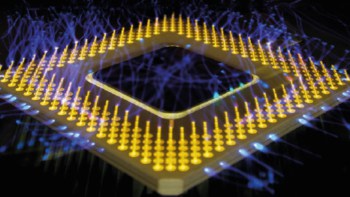The electrical engineer Jack Kilby, who invented the integrated circuit, died on Monday 20 June at the age of 81. By connecting separate electric components such as resistors, transistors and capacitors on to a single device, he laid the foundations for modern microelectronics and opened the door to the information age. Kilby was awarded one half of the 2000 Nobel Prize for Physics for his achievement, which took place shortly after he joined Texas Instruments in 1958.

Born in Missouri on 8 November 1923, Kilby became interested in electrical engineering while at high school and applied to study the subject at the Massachusetts Institute of Technology (MIT). However, he fell slightly short in his score on the entrance examination in 1941 and instead joined the US Army, which assigned him to radio-repair duties at an outpost in north-east India.
When the war was over, Kilby took a degree in electrical engineering at the University of Illinois followed by a master’s at the University of Wisconsin. After a spell at Globe Union, he joined Texas Instruments in Dallas in 1958, where he began building an integrated circuit, in which different components of an electronic circuit were integrated on a single piece of semiconductor about half the size of a paper clip. He demonstrated the first working integrated circuit on 12 September 1958.
Although that circuit had just one transistor, one capacitor and three resistors linked via gold interconnects on a germanium substrate, techniques for miniaturizing integrated circuits were soon developed. Today’s integrated circuits now cram millions of components onto a single chip to form a market with sales totalling $179 billion in 2004. Kilby, who held over 60 patents, later helped to invent the hand-held electronic calculator and the thermal printer.
The late Robert Noyce, who died in 1990, is also widely credited with inventing the integrated circuit while working for Fairchild Electronics in California. However, he filed his patent in July 1959 — some five months after Kilby filed his patent for “miniaturized electronics” and was also aware of Kilby’s work at the time. But Noyce, who co-founded Intel in 1968, developed the circuit as it was later to be manufactured in practice, with silicon as the semiconductor and the components connected with aluminium. After years of legal battles, Texas Instruments and Fairchilld eventually cross-licensed their technologies.


